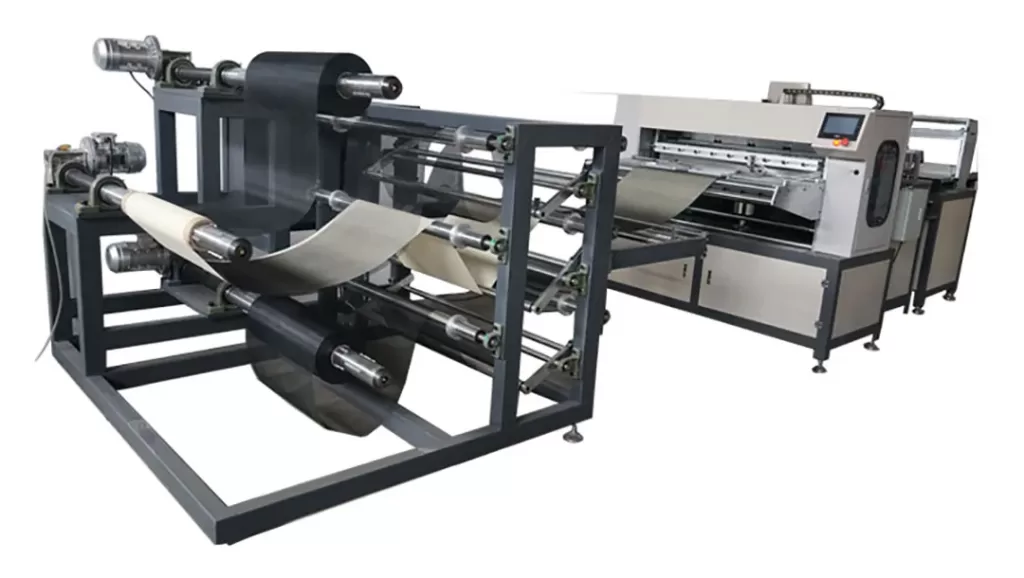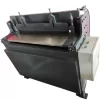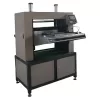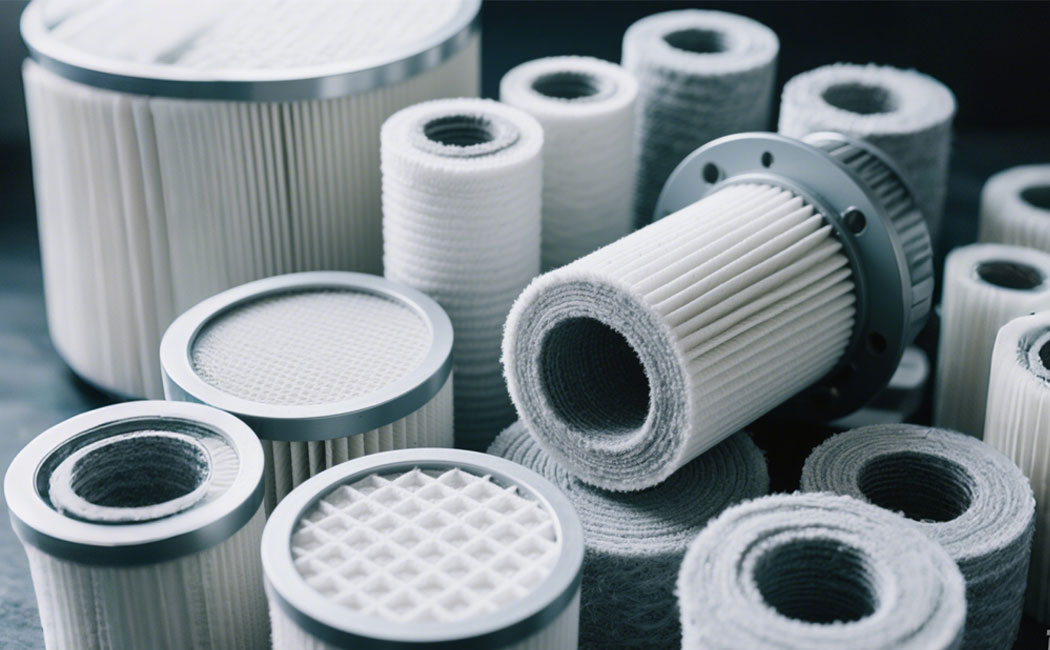What is a Type A feeding, CNC folding and slitting production line?
In today’s highly competitive manufacturing industry, accuracy and efficiency are crucial to maintaining a competitive advantage. Typing feed, CNC paper cutting machines and longitudinal cutting production lines represent great progress in automation technology, especially for industries that process sheets such as filter paper, non-woven fabrics and technical papers. This integrated system combines three essential components into a seamless workflow, revolutionizing how manufacturers approach high-volume production while maintaining consistent quality standards.

Overview of the system and key components
This production line is not just a collection of single machines, but a complex and coordinated system, in which three specialized units work perfectly and harmoniously. Full integration ensures the least manual intervention and the highest operational efficiency throughout the whole production process. This process begins with the type feeding system, which is the basis of the whole operation. This automatic unwinding system processes the main coil material through precise tension control, ensuring smooth and consistent material feeding. Equipped with pneumatic shafts and individual sensors for each layer, it maintains perfect alignment – a critical requirement for achieving optimal results in subsequent processing stages. The importance of this initial stage can not be overemphasized, because even the most advanced paper folding machines rely on correctly aligned material to work effectively. At the heart of the operation lies the CNC Folding Machine , where computer-controlled precision creates complex fold patterns with remarkable consistency. Operators can program specific parameters through an intuitive touch screen interface, including the folding height (adjustable in the range of 8-50 mm), the number of layers (1-7 layers) and pattern type, such as M or W configurations. The machine performs these folds at impressive speeds, up to 120 times per minute, while the heating plates keeps the temperatures between 0-180 C for materials that need heat setting. The last part is the longitudinal cutting machine, which can cut cleanly and accurately and separate the continuously folded material into individual products. This kind of high-precision paper cutting machines uses the rotating blade mechanism to ensure accurate cutting and no burr every time. The cutting cycle takes about 20 seconds, which is in complete synchronization with the output speed of the folding device.
The great advantages of modern manufacturing industry
The integration of these three systems creates substantial benefits that extend beyond simple automation: Enhanced Production Efficiency By creating a continuous, uninterrupted production flow, the integrated line eliminates the bottlenecks and downtime typically associated with using separate standalone machines. The seamless conversion between feeding, folding and cutting operations enables manufacturers to achieve 300-400% higher output than semi-automatic processes. This high-volume capability, combined with the potential for 24/7 operation, enables businesses to meet large orders efficiently while significantly reducing lead times. exceptional Precision and Consistency The CNC technology ensures paper folding machines accuracy within 0.1-0.3 mm tolerance, while the synchronized feeding and cutting systems maintain perfect registration throughout production runs. This consistency is particularly important for applications such as filter manufacturing, in which the product performance directly depends on maintaining accurate geometric specifications. The repeatability of the system ensures that every product, from the first one to the thousandth one, meets the same quality standard.
Operating cost optimization Although the initial investment needs careful consideration, the return on investment is realized through various channels. The automation reduces labor demand for the supervision of a single operator, and the accuracy of the system minimizes the waste of materials through accurate cutting and folding. In addition, the flexibility of the system allows rapid conversion between different product specifications, making it economically feasible for mass production and small customized orders.
Technical specifications and capacities
The characteristic of the system is that the working width of all modules is 1050 mm, which ensures compatibility and smooth material conversion. The feeding system adopts multiple 0.55 kW motors with independent tension control, while the folding unit adopts a 2 kW main drive motor supported by a dedicated 2 kW folding knife motor. The paper cutting machines module runs with a motor of 0.55 KW, and the whole system is managed through a centralized PLC touch screen control system. The technical design emphasizes reliability and accessibility of maintenance. All key components are easy for daily maintenance, and the solid structure ensures long-term durability even under continuous operation conditions.
Industrial Applications and market relevance
This technology has proven particularly valuable for automotive filter manufacturers producing air, oil, and fuel filters, as well as companies in the hydraulic equipment and water treatment sectors. The adaptability of the system to various materials, including filter paper, non-woven fabric and special synthetic papers, makes it suitable for a variety of industrial applications that need precise folding and cutting. The increasing popularity of this automatic solutions is reflected in market trends. The global packaging machinery sector – a key application area for this technology – is projected to reach $ 80.96 billion by 2030, reflecting a compound annual growth rate of 5.5%(Source: Grand View Research). This growth emphasizes the transformation of manufacturing to integrated automation solutions, which can improve productivity and product quality.
Frequently asked Questions and answers
Q:What materials types can the system handle?
A:The production line handles all kinds of materials, including filter papers, non-woven fabrics and technical documents used in filtration applications. While commonly referred to as a paper folding machine, the system’s capabilities extend to multiple material types with similar handling characteristics.
Q:How important is the feeding system to final product quality?
A:The type feeding system is the basis for obtaining consistent results. The independent motor control for each material layer can keep constant tension and prevent lateral deviation when running at high speed. Even the most accurate paper cutter will produce unsatisfactory results if there is no correct paper feed alignment.
Q:What kind of technical support do you usually have?
A:Manufacturers usually provide one-year comprehensive warranty, and provide technical support and operation training. Reputable suppliers usually provide additional services, including installation supervision, remote troubleshooting and spare parts available at any time to minimize potential downtime.
Summary
Type Feeding, CNC Folding and longitudinal cutting production lines are strategic investment for manufacturers seeking to improve their production capacity. By integrating a high-precision paper folding machine with automatic paper feeding system and precision paper cutter, enterprises can raise productivity, quality and operating efficiency to a new level. For companies in filtration and related industries, this technology provides a clear way to improve their competitiveness in an increasingly automated manufacturing environment, and at the same time provides flexibility to adapt to changing market demands and customer requirements.
Share:
Categories
- blog(46)
- Industry news(3)
- Technique articles(43)
Recent Posts

What is the melt filter trimming machine ...
11/20/2025 Comments Off on What is the melt filter trimming machine and how does it enhance the filtration system?
What is a Melt Filter Shrinking Machine ...
11/18/2025 Comments Off on What is a Melt Filter Shrinking Machine and Why is it Essential for Filter Manufacturing?
What is a melt filter extruder and ...
11/13/2025 Comments Off on What is a melt filter extruder and how does it enhance your filtration system?






